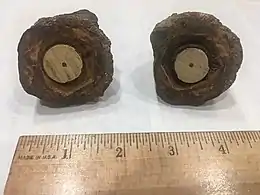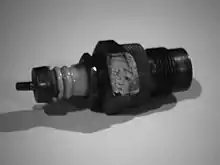Coso artifact
The Coso artifact is an object claimed by its discoverers to be a spark plug found encased in a lump of hard clay or rock on February 13, 1961, by Wallace Lane, Virginia Maxey and Mike Mikesell while they were prospecting for geodes near the town of Olancha, California, and long claimed as an example of an out-of-place artifact.[1] The artifact has been identified as a 1920s-era Champion spark plug. [2]

A spark plug encased in a 500,000-year-old "geode" would represent a substantial scientific and historical anomaly, as spark plugs were invented in the 19th century. Critics say that the stone matrix containing the artifact is not a geode, but concretion that can be explained by natural processes that can take place over decades or years.
Discovery
Following its collection, Mikesell destroyed a diamond-edged blade by cutting through the matrix and discovered the item.[1] In a letter written to Desert Magazine of Outdoor Southwest a reader stated that a trained geologist had dated the nodule as at least 500,000 years old.[3] The identity of the geologist and the means of dating were never clarified, nor were the findings ever published in any known periodical.[1] Furthermore, at the time of the artifact's reported discovery there was no method for dating the concretion.[4] There are examples of accretions surrounding iron or steel artifacts, some of them discussed by J. M. Cronyn. [5]
Criticism and analysis
There are several pseudoscientific theories for the artifact's origin,[1] among them:
- An ancient advanced civilization (such as Atlantis);
- Prehistoric ancient astronauts;
- Human time-travellers from the future leaving or losing the artifact during a visit to the past.

An investigation by Pierre Stromberg and Paul Heinrich, with the help of members of the Spark Plug Collectors of America, identified the artifact as a 1920s-era Champion spark plug, widely used in the Ford Model T and Model A engines. SPCA President Chad Windham and other collectors concurred with his assessment.[1]
Stromberg and Heinrich's report[1] indicates that the spark plug became encased in a concretion composed of iron derived from the rusting spark plug. Iron and steel artifacts rapidly form iron-oxide concretions as they rust in the ground.[5]
On April 12, 2018, Pierre Stromberg was contacted by the family of one of the co-discoverers of the artifact. Offered an opportunity to physically inspect the artifact, Stromberg accepted and also arranged for the artifact to be inspected by a geologist from the University of Washington Earth and Space Science department. The inspections confirmed the previous conclusion that the artifact was a 1920s-era Champion spark plug.[2]
See also
References
- Stromberg, P., and P. V. Heinrich, 2004, The Coso Artifact Mystery from the Depths of Time?, Reports of the National Center for Science Education, v. 24, no. 2, pp. 26–30 (March/April 2004).
- Stromberg, P., and P. V. Heinrich, 2018, The Coso Artifact Mystery from the Depths of Time?
- Maxey, V., 1961, The Coso Geode... in Letters...From Our Readers. Desert Magazine of Outdoor Southwest. v. 25, no. 5, p. 4. (May 1961).
- Walker, M. (2005) Quaternary Dating methods Wiley, New York, New York. 304 pp. ISBN 978-0470869277.
- Cronyn, J. M. (1990) The Elements of Archaeological Conservation Routledge, New York, New York. 326 pp. ISBN 978-0415012072.
External links
- Andrew O'Hehir (August 31, 2005). "Archaeology from the dark side". Salon.
- Dunning, Brian (February 25, 2014). "Skeptoid #403: Out of Place Artifacts". Skeptoid.